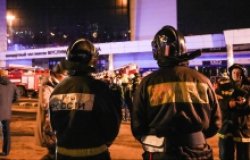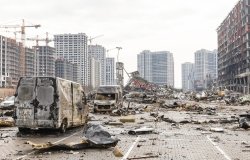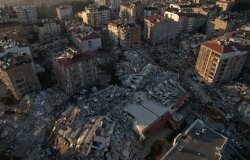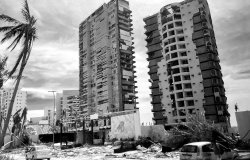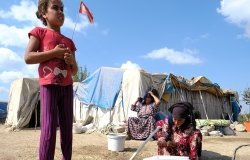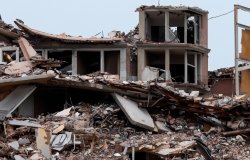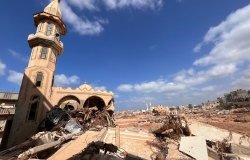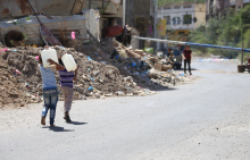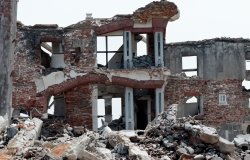Tapping the Potential of Displaced Youth in Urban Settings
“When young people claim their right to education and health – including sexual and reproductive health – they increase their opportunities to become a powerful force for economic development and positive change,” said Nicole Gaertner, of UN Refugee Agency and the U.S. Department of State, quoting Secretary of State Hilary Clinton at the Wilson Center.
Overview
“When young people claim their right to education and health – including sexual and reproductive health – they increase their opportunities to become a powerful force for economic development and positive change,” said Nicole Gaertner, of UN Refugee Agency and the U.S. Department of State, quoting Secretary of State Hilary Clinton at the Wilson Center on December 13.
Gaertner was joined by Josh Chaffin, senior program officer at the Women’s Refugee Commission, and Selin Mathews, project manager at Don Bosco India, to discuss the challenges faced by displaced young people and refugees in rapidly growing cities across the developing world.
Driven by young populations in Africa, the Middle East, South Asia, and Latin America, half the world is under 25 years old. Alongside this youthful age structure phenomenon is accelerating urbanization and an increasing number of refugees fleeing to cities instead of camps.
“We all hear about the youth bulge all the time – that the demographic youth bulge is exploding all over the world – and its seen as a security threat and to the extent that this kind of programming gets funded at all for youth it’s usually…for security reasons,” said Chaffin.
But Chaffin pointed out that in many cases, these populations of displaced young people represent the biggest resource a country has. “We firmly believe that when education, health care, basic needs are met for young people, and they have employment opportunities, that they can revitalize the economy,” he said.
The barriers to that happening, however, are many.
Out of the Camp, Into the City
From Nairobi to New Delhi, refugees are often the most vulnerable populations within cities. There has been a dramatic shift in the proportion of refugees in cities versus camps over the last decade, Gaertner said. Of the world’s 10.5 million refugees, only one-third live in camps and more than half now reside in urban areas.
“This trend creates new kinds of vulnerabilities,” she said.
Not to be confused as just another subset of the urban poor, refugees have a distinct set of needs from their contemporaries in camps. Whereas in camps, refugees get special government-funded attention, like schools or services from health clinics, in cities they must pay for transportation, healthcare, and sometimes even education, Gaertner said.
Refugees’ lack of status or “different” status, compared to citizens of the country in which they reside, creates protection challenges as well, Gaertner said, in terms of enforcing existing laws and international conventions. Their different status “often places a greater burden on refugee families who may not know whether or how to access services and employment.”
For example, refugees have access to government-sponsored education in New Delhi, but the medium of instruction is usually Hindi, which most don’t speak and aren’t keen to learn because they don’t intend to stay in India for long. Mathews and her team at Don Bosco therefore help refugees get official documentation so they can get into the few English schools.
Wasted Potential
Recognizing and addressing the difference between urban refugees and other vulnerable populations can help them reach their potential – both for their own good and the cities they reside in.
“A bundle of belongings is not the only thing a refugee brings to a new country,” said Mathews. “A refugee, when he comes to a new country, has his own hopes and aspirations, has a set of skills…there is much more to a refugee…apart from the trauma that one has gone through.” Within the already vulnerable urban refugee population, young people are the most neglected. There is a “glaring gap” in development programming for refugee youth, said Chaffin.
Getting an education is perhaps the biggest challenge.
Cost is an obvious barrier. Even if tuition is free, ancillary expenses such as books, uniforms, and transportation to and from school are often out of range for many refugees and displaced youth.
In his field work for the Women’s Refugee Commission in Cairo, Panama City, and Nairobi, Chaffin also found that demand for school is relatively low. “Kids are fairly unimpressed with the education system,” he said. “The classrooms are too packed, they say, and maybe the teachers are unmotivated.” There are very few opportunities for technical and vocational training, too. Even if these opportunities exist, many young people are not aware of them.
Lacking physical assets and access to capital or vocational skills, many displaced young people end up staying at home. “Work readiness skills – or the lack thereof – are a big issue,” Chaffin said, “even more important than technical skills.”
Staying at home hinders their ability “to learn, to earn, and to socialize,” and leads to feelings of isolation, anxiety, and depression, he said. “Males, in particular, are at risk of recruitment into gangs.”
Moreover, “overzealous” police are notorious for harassing young people and arresting them to solicit bribes from their families, said Chaffin. “The police problem is probably the number one thing that young people mention as a challenge to their daily life.”
Of those who do contribute to their households, often the kind of work they do – street selling and other informal, ad hoc jobs – doesn’t give them enough time to get an education. They’re “very time poor,” said Chaffin. The money they do make is generally insufficient and the work that they do tends to be unsafe.
Invisible Workers
“The 800-pound gorilla of issues in the urban refugee settings that we visited is adolescent girls,” said Chaffin, “especially…young women who work as domestic workers.”
“They tell us that they face various types of exploitation and abuse; they often don’t get paid or they get paid very poorly; their rights are trampled on.”
Girls sometimes also face cultural constraints to education, “especially if they’re coming from more traditional societies,” where child marriage or rules about interacting with boys can prevent them from attending school.
They’re a very different demographic to work with, Chaffin noted, because of their invisibility. It’s difficult to quantify how many there are because they disappear inside people’s homes and their employment is typically informal, so they don’t receive the recognition and protection of labor laws.
In India, Mathews said they see the same thing and understand that young women, and girls especially, face different challenges. Based on the recommendation of the Women’s Refugee Commission, they have moved from a “protection model” – which emphasized psychological support – to a “self-reliance model” that is focused on income-generation and livelihood activities like knitting and weaving textiles.
A City of Opportunities
Despite often being ignored by official services, “the city presents a lot of opportunities for [displaced] young people, opportunities they don’t necessarily have in a camp setting or a rural setting,” Chaffin said. “In the city you’ve got private firms, access to productive technologies, access to – potentially – continuing education, internships, mentorships, apprenticeships.”
The unique set of needs of urban youth, and especially refugee and displaced populations, raises operational questions for the humanitarian community about the extent to which it should direct more attention to cities. At the moment, refugee camps remain the focus of most organizations working in this area.
The 2009 UN Refugee Agency’s urban policy was a start – “a great thing,” said Chaffin – but it is not always implemented. Governments routinely restrict the right to work and freedom of movement of foreign nationals in urban settings, he said.
“At [the Bureau of Population, Refugees, and Migration] we’ve really had to…refocus our efforts on not only providing assistance to refugees and conflict-affected populations in camp-based settings, but also looking at these other situations,” said Gaertner.
But given the proportion of the world in this vulnerable age group right now, “we feel it is incumbent on all of us to increase our efforts to meet these needs of adolescents and youth, and secure their healthy transition to adulthood.”
Drafted by Payal Chandiramani, edited by Schuyler Null.
Sources: Don Bosco India, Human Rights Watch, UN High Commissioner for Refugees, UN Population Division, U.S. Department of State, Women’s Refugee Commission.
Speakers
Josh Chaffin
Selin Mathews
Nicole Gaertner
Hosted By

Environmental Change and Security Program
The Environmental Change and Security Program (ECSP) explores the connections between environmental change, health, and population dynamics and their links to conflict, human insecurity, and foreign policy. Read more

Urban Sustainability Laboratory
Since 1991, the Urban Sustainability Laboratory has advanced solutions to urban challenges—such as poverty, exclusion, insecurity, and environmental degradation—by promoting evidence-based research to support sustainable, equitable and peaceful cities. Read more

Africa Program
The Africa Program works to address the most critical issues facing Africa and US-Africa relations, build mutually beneficial US-Africa relations, and enhance knowledge and understanding about Africa in the United States. The Program achieves its mission through in-depth research and analyses, public discussion, working groups, and briefings that bring together policymakers, practitioners, and subject matter experts to analyze and offer practical options for tackling key challenges in Africa and in US-Africa relations. Read more

Global Risk and Resilience Program
The Global Risk and Resilience Program (GRRP) seeks to support the development of inclusive, resilient networks in local communities facing global change. By providing a platform for sharing lessons, mapping knowledge, and linking people and ideas, GRRP and its affiliated programs empower policymakers, practitioners, and community members to participate in the global dialogue on sustainability and resilience. Empowered communities are better able to develop flexible, diverse, and equitable networks of resilience that can improve their health, preserve their natural resources, and build peace between people in a changing world. Read more
Thank you for your interest in this event. Please send any feedback or questions to our Events staff.
